There’s more to feed your SLS 3D printer today than PA12 (nylon 12), although it remains the most popular choice. Recent advances in sinter-able polymers are delivering better material properties, but reducing waste and boosting re-use percentages is now a major focal point.
The SLS process wastes enormous amounts of material since most of the powder left over from a single print can’t be reused. The laser and heat from making one batch of parts leads to some shrinkage of the surrounding powder, which is typically remixed with fresh powder to form the next powder bed.
Lowering that remix percentage (or refresh rate) should lower the overall cost of SLS printing, which is especially important as manufacturers eye it for larger volumes of parts. Keep in mind, however, that refresh rate isn’t just a material issue; your printer also effects your refresh rate.

Toward the goal of higher sustainability, on-demand part maker Materalise launched Bluesint PA12 last year which is made up of 100% re-used powder. But Bluesint PA12 isn’t a powder you can order and use in your SLS 3D printer; instead Materialise offers it only as a service because, in addition to the powder, printing parameters, cooldown, and post-print steps are very tightly controlled and limited to particular SLS printers, including the Sindoh S100.
Back in November, EOS subsidiary ALM launched the first carbon-neutral polymer material line based on PA11. To gain certification as a carbon-neutral product, the PA11 is bio-based, plus ALM took additional steps to further off-set ancillary carbon generation, including installing solar panels on its’s Texas headquarters.
German start-up Launhardt, launched Powder Monkeys rePA12 SLS powder formulated from recycled PA12 and designed for lower-power benchtop SLS printers.
Despite advances in material variety, a recent industry report noted low adoption. “If you talk to users, they’re reluctant to adopt new materials, which is surprising because users, for years, asked for PA6, PP, TPU, and more materials for powder bed fusion,” says Matthias Schmidt-Lehr of Ampower, which produced the report. “But now, it seems they are so used to using PA12 – and so many of their applications are designed for it – that they don’t intend to change any time soon.”
Nonetheless, the range of powder materials available today for powder bed fusion 3D printers is steadily expanding along with the number of material manufacturers – who have long supplied polymer powders for injection molding and are now offering special blends for 3D printing. However, that doesn’t mean every powder bed printer (SLS or MJF) can print with every powder out there. In fact, quite the opposite. Today’s printers use a wider range of technologies than in the past, and some are applicable only to certain powders.
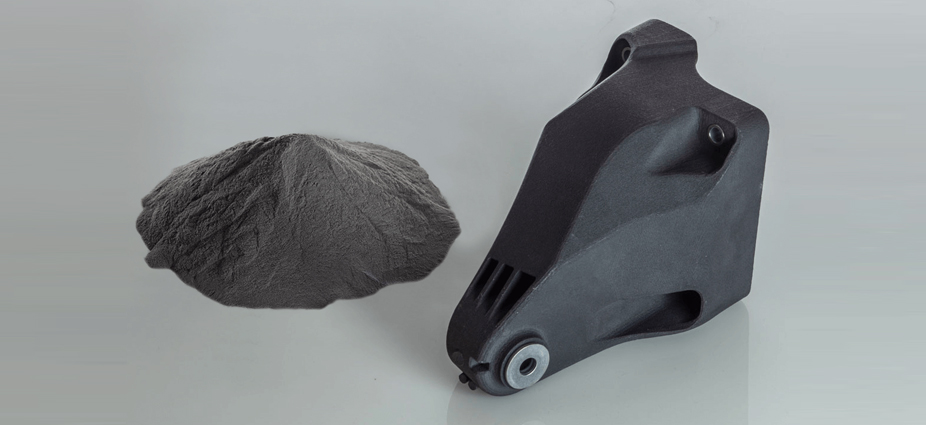
For example, today’s smaller benchtop size SLS printers often don’t have a laser powerful enough to handle some materials, such as PEEK powder, but can handle PA and TPU with ease. The smaller machines also lack a lot of the sophisticated thermal management necessary to keep the powder bed at the required temperature, which for PEEK is over 300 °C.
SLS printers with open parameters for third-party materials typically offer you the widest choice of materials.
If you’re looking to print parts with certain properties, there are standards from the regulating bodies, ISO and ASTM, that material manufacturers follow. All manufacturers should offer a full spec sheet detailing the strength, flexibility, durability, and heat resistance of their powders among many other attributes. Of course, this information might not be valid for all machines, and attributes can vary by the settings you use on your printer, such as laser power.
Let’s take a look at the powders and manufacturers to find the best fit for your polymer powder bed printing needs.
Most Popular SLS Powders
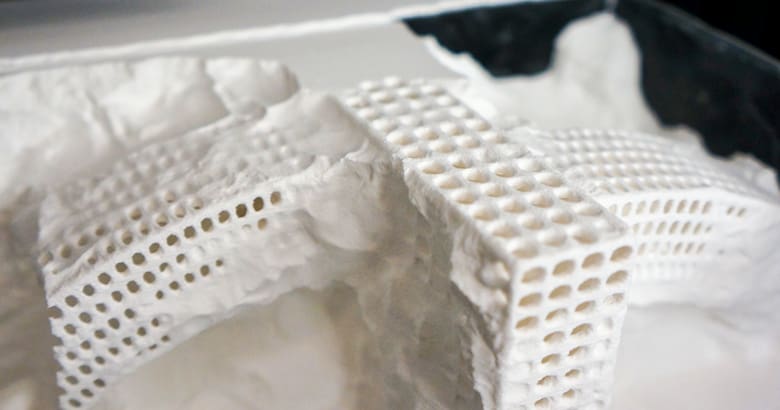
The powders in this guide are all in the plastic family. Their properties range from stronger than solid aluminium to softer than rubber and everything in between.
Of course, you can sinter metal powder, however that’s a process called direct metal laser sintering (DMLS), selective laser melting (SLM), or electron beam melting (EBM), but here we’re sticking to plastics only.
For selective laser sintering (SLS), these are the most commonly used types of powders:
Price of Powder & Buying Tips
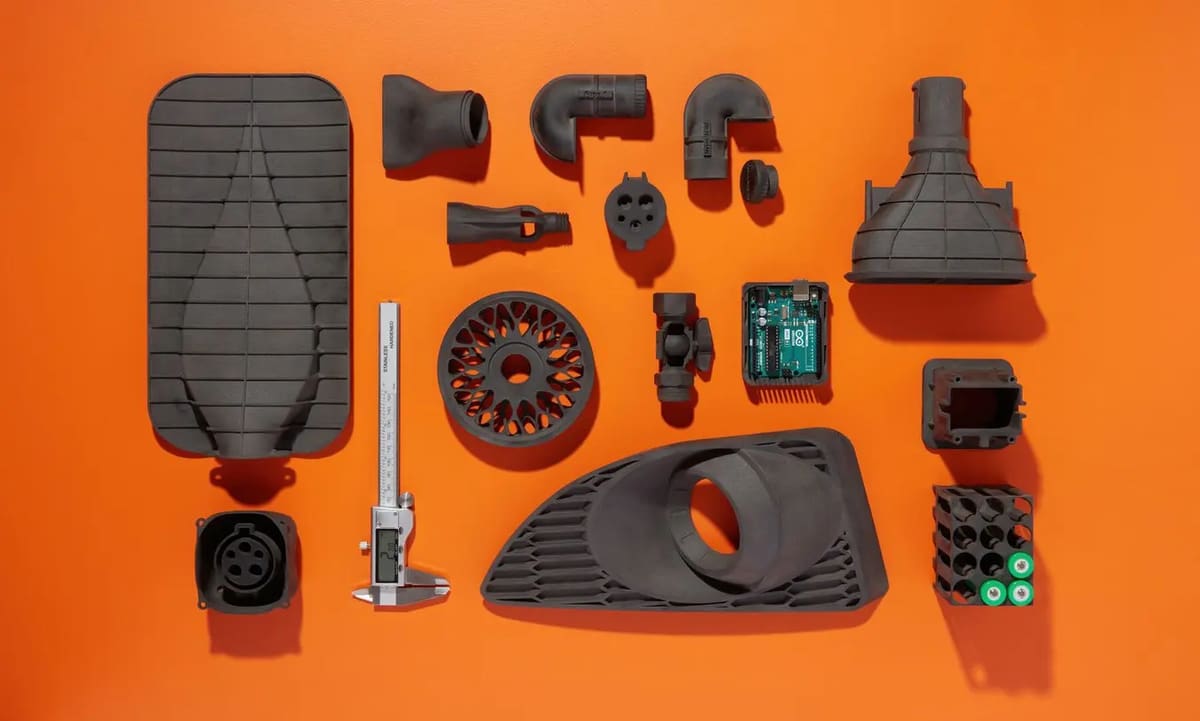
If you’re looking to save money on your SLS materials, there are limited options. This is due to the relatively small universe of powder manufacturers and the fact that your printer manufacture may limit you to proprietary powders or only certify a few brands for use.
If your printer offers an open-materials platform, you’ll have more choices and can shop around, but prices of SLS powders do not range dramatically by brand. Just to give you an idea of prices:
Because SLS powder isn’t exactly cheap, it’s important to consider how your printer handles unused powder left over after a print. This powder can be reused, but loses a bit of its original properties. A common method is to remix used powder with fresh powder. Some powders have a high “refresh rate” which means they can be used with a lower percentage of fresh powder for new prints. As we mentioned above, your printer, the size of your print bed, and the volume of what you last printed also effect your refresh rate. Some SLS printers can give your an automated calculation of how much virgin powder your should mix with the last print’s left over to achieve good results.
You may notice that the same materials for injection molding or another process are cheaper. That’s because of the extra step to make a consistent powder out of the material so that it’s suitable for SLS printing.
The most expensive SLS powders today are all in the PAEK family and this may just be the most rapidly growing material, increasingly driven by the aerospace, healthcare, and oil and gas industries that have traditionally used these materials through machining but are turning to SLS solutions that can provide consistent performance, enable complex design, and even recyclability.
Applications of SLS Powers
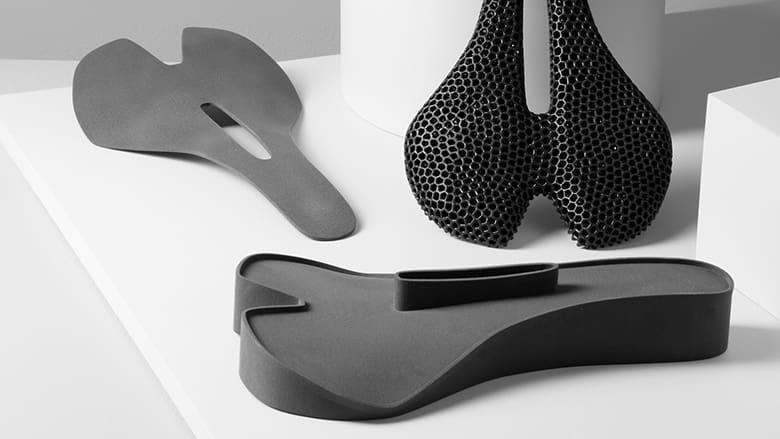
SLS printing technology produces parts that are generally much stronger than resin and filament printing technologies. SLS printed parts rival or surpass the strength of metal parts in many applications while being far lighter and less expensive. This one attribute has led to wide SLS part use in aerospace, automotive, and manufacturing.
The technology also produces more isotropic or solid parts than filament and rival injection molding for smooth services and uniform mechanical properties. This characteristic has made SLS popular for end-use consumer products, electronic housings, functional prototypes, and sporting goods.
Another feature of SLS printing that sets it apart from resin and filament methods of 3D printing is that parts don’t require any supports, which enables greater geometric freedom. Couple this with the generally higher resolution of SLS prints, and you have a perfect technology for medical applications, such as prosthetics and complex assemblies used in automotive and mechanical prototypes.
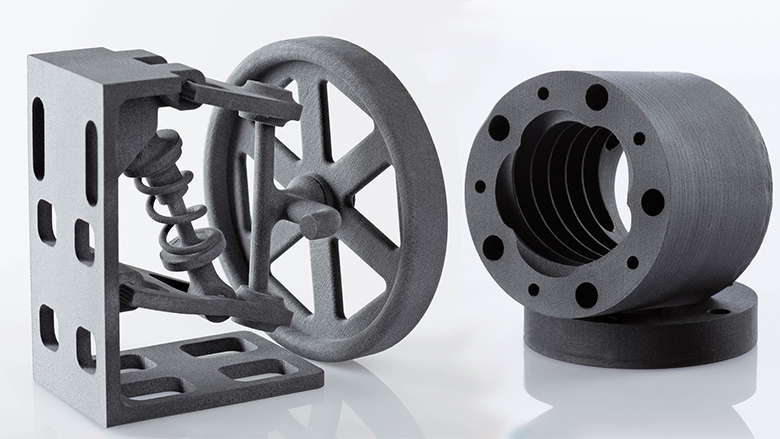
Best Brands & Manufacturers
All polymer powders are not the same, even if they are all in the same chemical family. Different brands of powder have different characteristics, while still all being, for example, PA 12. It’s the same for the other types of powders, and the variety can get confusing.
Further confusing the material landscape is the fact that you’ll find materials available from chemical companies, such as Evonik, and materials from printer manufacturers, such as Prodways that have taken existing materials and tweaked them to perform optimally on their printers.
For example, printer manufacturer Sinterit offers three types of TPU material, FlexaSoft, FlexaWhite, and FlexaGrey. You’ll have to dive into the materials’ data specification sheets to discern the difference, which happens to be color and variation in strength and elasticity. Printer manufacturer XYZprinting also offers its own TPU material called sProTPU that is actually a TPU-88, which means it has a Shore A Hardness of 88.
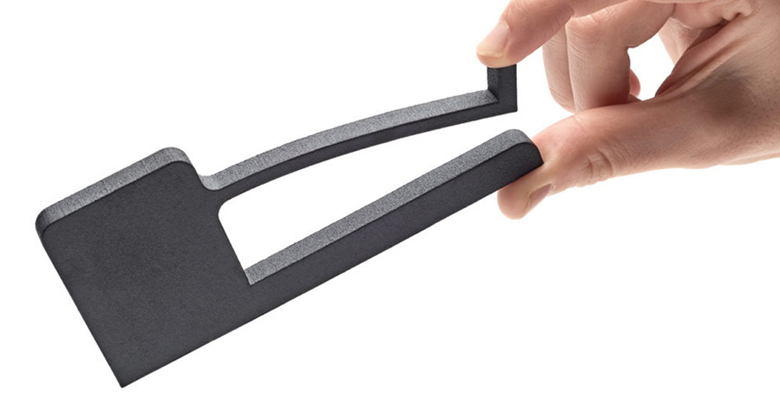
At this point, you’re either thinking to yourself, A) I don’t really care about Shore Hardness, I just need a flexible material for my prototype, or B) tell me more about Shore Hardness and Tensile Strength because my application has critical material property specifications.
If you’re in group A, what’s critical for you to know is to only use the powders recommended or certified for your printer by the manufacturer. Third-party powder materials not certified for use in your SLS printer may not yield top results. Always check the specs of your machine against the requirements of the powder, especially the required laser strength. Color also is very important. Some lasers, such as fiber lasers and diode lasers don’t work well on white or light-colored powders and require a dark grey or black powder.
If you’re in group B and have specific mechanical properties you’re looking for in an SLS print, such as how much stress the part can take before breaking or how impact-resistant it should be, you’ll find this information in the spec sheets of the individual products. Fortunately, you don’t have to visit each manufacturer’s website and download all of their details; you can search the material database at the Material Data Center (by the M-Base Engineering + Software company) or the somewhat-quirky but generally reliable Senvol Material Database.
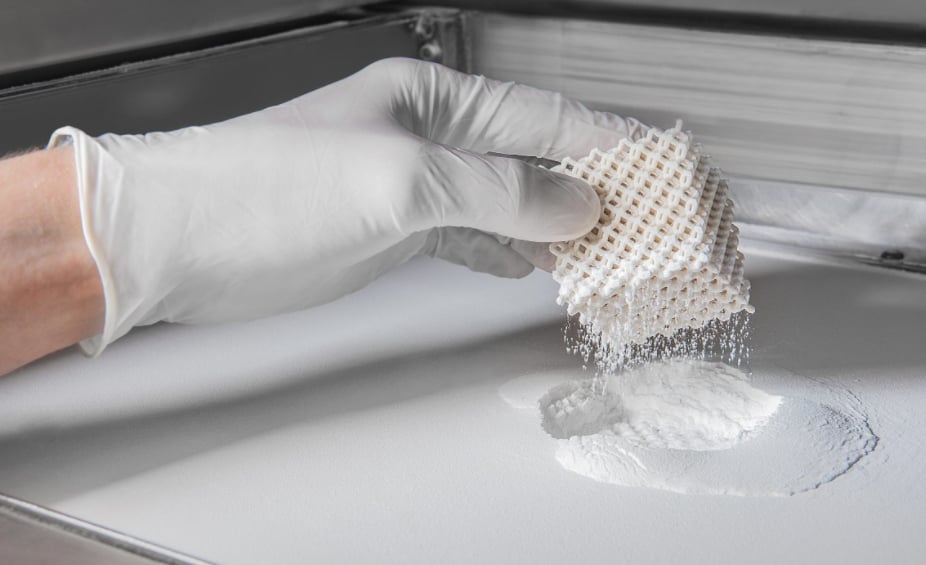
You might be interested to learn that specialty polymer manufacturers can work alongside your 3D printer manufacturer to custom create SLS powders for your specific application. For example, if you require a part with a specific amount of flexibility coupled with a specific amount of strength, specialty chemical companies, such as Evonik, Arkema, and Solvay can custom formulate an SLS powder for you tuned to the 3D printer you have.
As mentioned earlier, all powder manufacturers provide detailed reports on their powder performance in terms of about 10 or more specific measures but keep in mind that performance can vary depending on your SLS 3D printer and the settings you use (layer height, laser power, etc.)
Below we take a look at the top brands in SLS powder and what they offer.
Sinterit
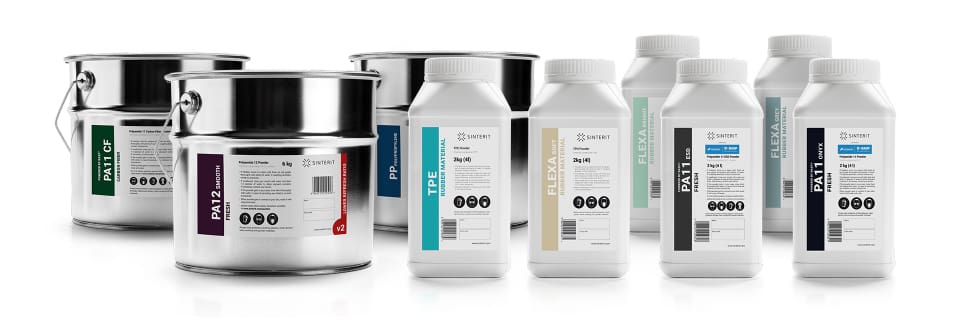
Sinterit is one of the fastest-growing SLS material and 3D printer makers offering seven powders and four printers.
The company also just announced a partnership with BASF Forward AM on powder development with an eye toward making economical powders for lower laser power benchtop SLS 3D printers.
The advantage of Sinterit powders is that they are widely available from a range of distributors in the US and Europe.
Sinterit Product Portfolio
- PA12 Smooth
- PA11 Onyx
- PA11 CF (Carbon Fiber)PA11 ESD
- Polypropylene (PP)
- FLEXA GreyFLEXA Bright
- FLEXA Soft
- TPE
Formlabs
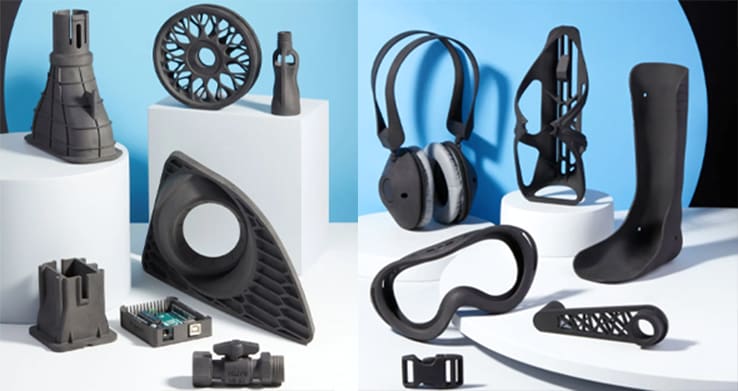
Formlabs offers three powders made specifically for its Fuse 1 SLS printer, which doesn’t completely preclude them from being used on other SLS printers.
Its newest TPU 90A powder enables users to create flexible, skin-safe parts that can be tailored for specific applications. The glass-filled material Nylon boasts enhanced stiffness and thermal stability for demanding industrial environments. Choose Nylon 12 GF Powder to produce stiff functional prototypes or end-use parts for applications where structural rigidity and thermal stability are critical.
Formlabs Product Portfolio
- Nylon 12 Powder
- Nylon 12 GF Powder
- Nylon 11 Powder
- TPU 90A
Ultrasint by BASF Forward AM

Forward AM is the 3D printing division of chemical giant BASF, which offers the Ultrasint powders designed for ease of use on most common SLS printing equipment and HP Multi Jet Fusion. In addition to the material itself, the company offers technical support and the full spectrum of services from design and simulation through to post-treatment of printed parts.
Ultrasint Product Portfolio
- Ultrasint PA6 Line (PA 6, PA 6 Mineral Reinforced)
- Ultrasint PA 11 Line (PA 11 White/ Black, PA 11 Electrostatic Safety Discharge, PA 11 Carbon-Fibre Reinforced)
- Ultrasint PP (PP nat 01, HP 3D High Reusability PP)
- Ultrasint TPU Line (TPU01, TPU 88A White/Black)
Infinam by Evonik
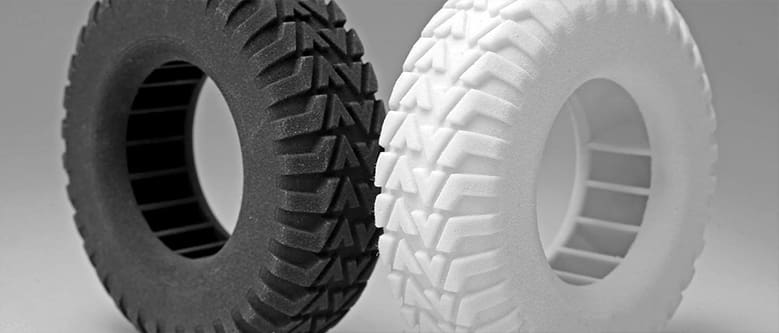
Evonik has been developing polymer powder material for the additive manufacturing market since 1996 and is a world leader in the production of polyamide 12 powders (PA 12), which have been used in 3D printing for over 20 years. The development of the flexible high-performance powder expands Evonik’s existing product portfolio of synthetic materials for 3D printing. In addition to the company’s ready-to-use materials it also works directly with 3D printer manufacturers and end users to develop custom materials for specific use cases.
The Infinam PA 12 is approved by the US Food and Drug Administration for food contact.
INFINAM Product Portfolio
- Infinam PA 12
- Infinam PA 613
- Infinam TPA (Thermoplastic amide)
- Infinam TPC (Thermoplastic copolyester)
Arkema

With a 50-year legacy of developing high-performance polymers across an array of diverse markets, Arkema offers a comprehensive range of fine polyamide powders for powder bed fusion technologies. With its partners, Arkema designs new materials and uncovers new applications to help its customers realize the full potential of 3D printing.
Arkema Brands Product Portfolio
- Rilsan PA 11
- Kepstan PEKK
- Orgasol PA 12
PowderMonkeys
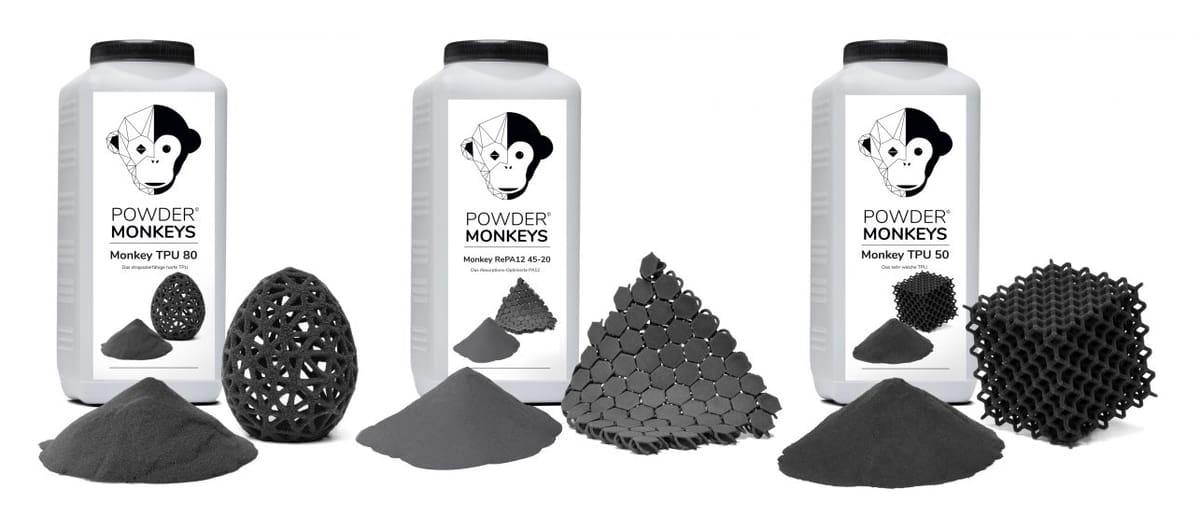
Inspired by the increasing availability of desktop SLS systems for hobbyists, architects, and engineers, Martin and Christian Launhardt founded PowderMonkeys in 2020 to offer SLS materials tuned to the less powerful lasers of these systems that, they say, required powder materials with a corresponding absorption. They also aim to offer more economical and sustainable alternatives.
The TPU powder is hydrolysis-free and does not require any refresh rates, the company says. The PowderMonkey rePA12 is a mixture of refurbished PA12 with a portion of virgin PA12.
PowderMonkeys Product Portfolio
- Monkey TPU 80
- Monkey TPU 50
- Monkey RePA12 45-20
DuraForm by 3D Systems
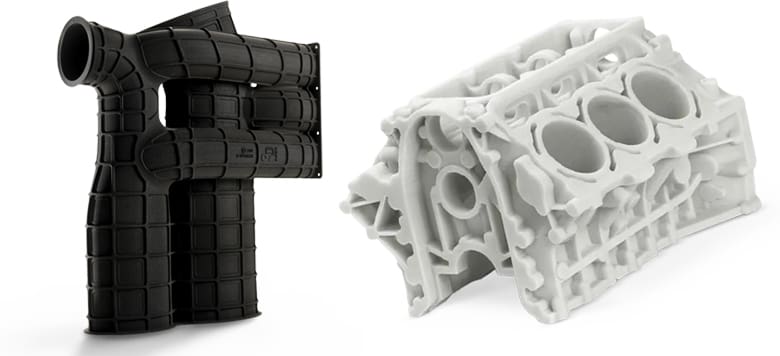
3D Systems not only makes a wide range of 3D printers but also manufacturers its own materials. For SLS printing, the company offers a range of powders for prototypes, production tooling, and end-use production parts offering a range of toughness, heat resistance, flame retardancy, flexibility, or food-grade and medical-grade options.
DuraForm Product Portfolio
- DuraForm PA 12 line (DuraForm ProX PA, DuraForm PA, FR1200, ProX FR1200 flame retardant, ProX AF+ aluminium filled, HST Composite, ProX HST Composite fiber reinforced, ProX GF, GF)
- DuraForm PA 11 line (ProX EX NAT, ProX EX BLK, EX Natural, EX Black)
- DuraForm TPU line (TPU Elastomer, Flex)
- Polystyrene (CastForm PS)
Alumide & PrimeCast from EOS
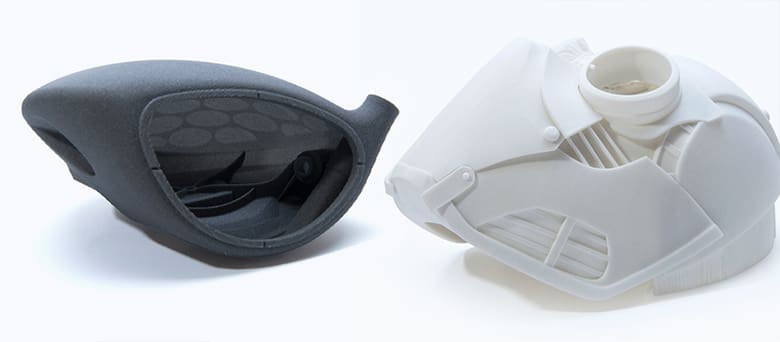
Printer manufacturer EOS is another company that makes its own powders optimized for its own machines. They offer a comprehensive portfolio of plastic and polymer materials for laser sintering in additive manufacturing. EOS says it is also continuously developing its range of high-tech materials to meet special customer requirements.
EOS Product Portfolio
- PA 12 line ( PA 2200, PA 2201, PA 3200 GF, Alumide, PA 2210 FR)
- PA 11 line (PA 1101, PA 1102 black)
- TPU (EOS TPU 1301)
- Polystyrene (PrimeCast 101)
- PEKK (ALM HT-23 with 23% carbon fiber)
Luvosint by LEHVOSS
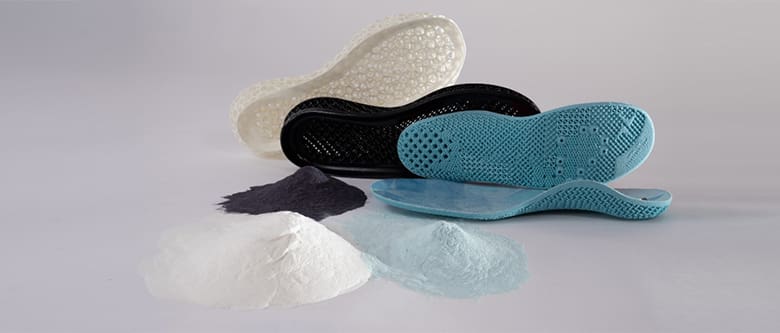
Lehmann & Voss & Co. (LEHVOSS) is a German chemical manufacturer offering the Luvosint brand of SLS materials. In addition to their standard material portfolio, they also supply individual, tailor-made materials.
Luvosint Product Portfolio
- Luvosint TPU
- Luvosint PP (polypropylene)
- Luvosint PA
Rolaserit by AM Polymers
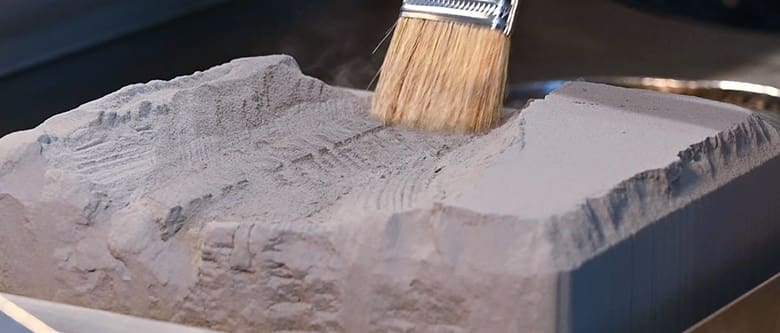
German material manufacturer AM Polymers offers the Rolaserit line of SLS polymers and can tailor the material for your application. Based on more than 10 years of experience in the field of additive manufacturing, the company currently offers six plastic powders aimed at being easy to process while maintaining high mechanical part properties.
Rolaserit Product Portfolio
- Rolaserit PA 6
- Rolaserit PP (PP 01, PP 01 GR)
- Rolaserit PE (PE 01 GR)
- Rolaserit TPU
- Rolaserit PBT (PBT 01)
Lead image source: PowderMonkeys
License: The text of "SLS Powder Material Buyer’s Guide" by All3DP Pro is licensed under a Creative Commons Attribution 4.0 International License.
